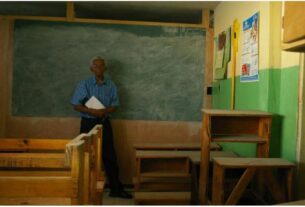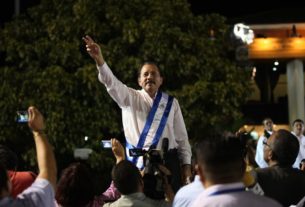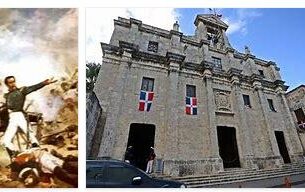Grenada, island state of the eastern Caribbean. The state consists of the main island of Grenada (310 square kilometers), the islands of Carriacou, Ronde Island and Petite Martinique as well as about 30 small islands in the southern part of the Grenadines. Grenada is located northwest of Trinidad and Tobago, northeast of Venezuela and southwest of St. Vincent and the Grenadines.
Grenada is often called the “spice island” because of the large amount of spices grown here; a nutmeg is shown in the flag. Grenada is the world’s second largest producer and exporter of nutmeg. The country was invaded by a US-led force in 1983. The capital is St. George’s.
The name Grenada is after the Kingdom or the city of Granada in Spain. National anthem is “Hail Grenada”. Grenada has given names to the Grenadines.
Geography and environment
The islands are of volcanic origin. The island of Grenada consists of five volcanoes with the youngest, Mount St. Catherine, as the highest point at 840 meters above sea level. The islands are partially deforested due to pasture and logging. There are several waterways with beautiful waterfalls. On the main island is the large crater lake Grand Etang. The active undersea volcano Kick ’em Jenny is located northwest of the main island and west of Ronde Island.
In the north and west the coast is steep, in the south and east lower with plains, bays and peninsulas. The island of Carriacou about 30 kilometers northwest of Grenada is lower and largest of the Grenadines.
The climate is tropical and humid during the rainy season and cool by the trade wind in the dry season. In the lowlands, the average temperature for the year is about 26 o C and with small seasonal and daily variations. Grenada is on the southern edge of the hurricane belt; several hurricanes have done great damage. It rains most in June-November, least in January-April. In St. George’s, the annual rainfall is 1520 millimeters. It’s raining more in the highlands. Carriacou is considerably drier than Grenada.
Much of the original inland rainforest has been cut up to 840 meters above sea level and replaced by other forests and plantations. Teak and mahogany are valuable wood species. Carriacou has a vegetation characterized by drought-resistant species such as acacia and cactus.
The wildlife have relatively few but distinctive species mona lemur introduced by African slaves, gold hare, opossum, niringet armadillo and a few species of bats. Common birds include several hummingbird species and brown pelican. Grenadadue is only found on Grenada. The reptiles include iguanas and turtles.
People and society
Most live on the main island of Grenada. About 82 percent are descendants of African slaves. Grenadines of Indian origin make up the second largest ethnic group. A few descendants of indigenous peoples.
Life expectancy at birth is 76.62 years for women and 71.24 years for men (2014).
English is the official language. The population speaks mainly English-based Creole ; French-speaking Creole has limited prevalence.
Roman Catholic Christians make up about 53 percent of the population, Anglican Protestants about 14 percent, and other Christians about 33 percent. Hindus, Muslims, Buddhists, Baha’is and Rastafari constitute small groups.
Many Grenadines have emigrated to other parts of the Caribbean, such as Barbados and Trinidad, as well as to the United States, Canada and the United Kingdom.
State and politics
Grenada is a parliamentary-democratic unitary state. The country is a constitutional monarchy with the British Queen as the formal head of state. The monarch is represented by a Governor General. The government is based on the majority in parliament which has two chambers: the upper house (senate) with 13 members appointed by the governor general and the lower house (House of Representatives) with 15 members elected for up to 5 years in a one- vote majority.
The country is divided into six parsonages. Carriacou and Petite Martinique are considered an “dependency” or seventh vicarage. Grenada does not have municipal autonomy.
Grenada is a member of, among others, the UN and the UN’s special organizations, the Commonwealth, the Organization of American States (OAS), the Caribbean Community and the Common Market (CARICOM), the Organization of Eastern Caribbean States (OECS), the World Bank and the World Health Organization.
Grenada does not have its own military forces. Royal Grenada Police has its own special service unit and a coastguard under police control. In the event of an emergency or war, the police force can be used as a defense force.
History
The original population of Grenada, the Arabs, was displaced or killed by caribou. During his third voyage to the New World, Kristoffer Columbus came to Grenada in 1498. English merchants made an unsuccessful attempt to found a colony in 1609, but were displaced by the indigenous peoples. The French governor of Martinique, who had bought Grenada, established a small settler community at St. George’s in 1650. After several battles, and with reinforcements from Martinique, the French defeated the Caribbean.
The island was a French possession in the period 1674–1762, then a British colony in the periods 1762–1779 and 1783–1958; Grenada was a crown colony from 1877. Grenada was a member of the West Indies Federation from 1958 to 1962 and from 1967 associated state within the Commonwealth of Nations.
Grenada became independent in 1974, and the corrupt Eric Gairy of the Grenada United Labor Party (GULP) collaborated with the Pinochet regime in Chile, among others. In 1979, the Black Power- inspired New Jewel Movement (NJM), led by Maurice Bishop, seized power in a coup d’état and created the People’s Revolutionary Government. In the United States, concern increased as Grenada began cooperation with the Soviet Union, the GDR and Cuba; the latter country prepared Grenada to face a possible invasion. After internal strife, a military council seized power in 1983 and executed Bishop. Six days later, Grenada was invaded by troops from the United States and 6 West Indies, capturing the military leaders. The following year, free elections were held.
In 2004, Grenada was hit by Hurricane Ivan, which destroyed or damaged 90 percent of the island’s homes. The north coast was hit by Hurricane Emily in 2005. The 2013 election was won by the New National Party, led by Keith Mitchell, who became prime minister.
Economy and business
Tourism is concentrated to the southwest coast and is Grenada’s largest source of income. The island is frequented by cruise ships. The service industries account for 78.5 per cent of GDP (2013).
Grenada is a leading producer of several spices, especially nutmeg. A lot of bananas, cocoa, citrus fruits, sugar cane, corn, ginger and coffee are grown on Carriacou cotton. Cattle keeping is most important at Carriacou. Agriculture accounts for 5.6 per cent of GDP.
Manufacturing (15.8 per cent of GDP) produces food, textiles and electronic components, among other things. Some fishing is being conducted, and fish processing is under development.
Knowledge and culture
Schooling is compulsory and free for children aged 5-16. High school is not compulsory. Grenada has a technical school, teacher school and fishery school. St. George’s University provides education in medicine and veterinary medicine. It is also a branch of the University of the West Indies.
There are no daily newspapers; four English-language newspapers are published weekly. Grenada Broadcasting Network broadcasts radio and television programs; a private company broadcasts television. There are a number of private radio stations.
Folk tales have African and French influences. Well-known authors are Gus John (1945–), Merle Collins (1950–) and Tobias S. Buckell (1979–).
Popular music forms are calypso, soca, zouk, reggae and dancehall. Grenada is also known for jazz ; best known is pianist and songwriter Eddie Bullen, who has been living in Canada since 1980. David Emmanuel is a renowned reggae and jazz musician. Carriacou is known for the Afro-Caribbean song style Big Drum; funeral music is part of the island’s folk music.
African dance exists in a developed form; the same goes for European quadrillions.
It is an annual carnival in August. Some French architecture from the 18th century is preserved. Cricket and football are the most popular sports.





